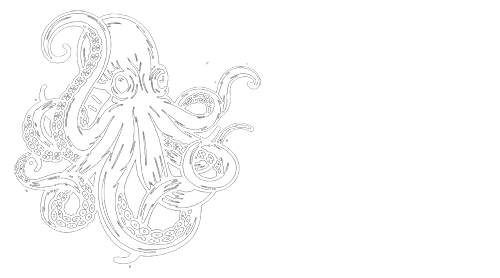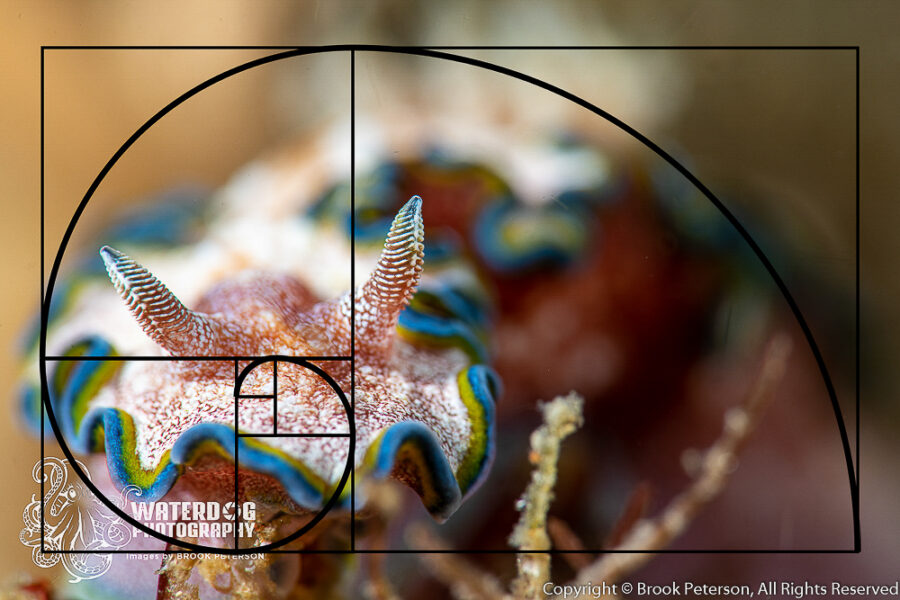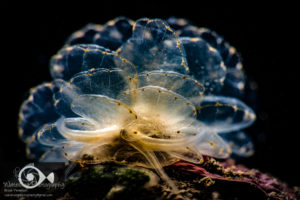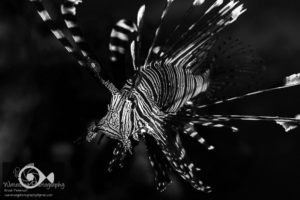Macro photography is a favorite pastime of many underwater photographers. For some, it is the underwater macro world that captured their imagination in the first place. There are so many tiny aquatic critters that can be unbelievably beautiful, amazing, interesting, or just plain weird. Sometimes the strangeness defies reason, and we are compelled to show this through our photos to our friends, the land dwellers. I am a firm believer that “Good Things Come in Small Packages.” But how do you create an image with monster impact from a subject with such tiny proportions?
First Things First: Equipment

Without proper equipment we are at a disadvantage to show what we really see. This includes our ability to see the critters in the first place. I recommend a good mask with magnifying lenses. Much of the most beautiful detail may not be visible to us without the use of magnifying lenses. This leads to the use of magnifying lenses for the camera. A good macro lens is a must for any macro photographer. For DSLR users, I recommend a 50/60mm or 100/105mm macro lens and their equivalent for mirrorless cameras. There are some compact cameras that have excellent macro capability, without the need for additional magnification, such as the Olympus TG-6.
In addition to the camera and housing, there are some wet lenses that can enhance your ability to photograph the tiniest animals. I recommend Nauticam’s SMC or CMC diopter, but there are many brands of diopters that can be mounted to the camera’s housing. A diopter is basically a thick magnifying lens that allows you to photograph a subject at a greater than 1:1 ratio. Certainly, there are many other tools that can enhance creative macro photography, but perhaps those are best taught in person with hands on experience. Sufficient to say that good macro photography starts with good basic tools, and a desire to show off the most interesting aspects of the ocean’s littles.

What makes a good photo great?



All good photos have three things in common; good or creative lighting, interesting composition, and they tell a story or show a behavior. These are the things you should be thinking of when making images. Be careful that you don’t fall into the trap of taking identification photos just to prove you saw something. It can be very exciting to see your first blue ring octopus and you may want to prove it. So go ahead and take that ID shot, but then concentrate on making a beautiful image. Is there something you can do to isolate the subject from its background? Would it look better from a different angle? Is the subject “doing” something? i.e. hunting, mating, brooding, feeding, hiding?
Creative Lighting

The use of light is probably the most extensive and important aspect of art in any form but is especially important in macro photography. Light and the lack of light is often used in a photograph to isolate a subject from its environment. For example, a subject that is lit will stand out from a background that is not lit. This can be accomplished by angling the strobes so that the edge of the strobe light falls on the subject, but not on the background. Light spreads out from your strobes in the shape of a cone, so if your strobes are turned toward your camera housing, you can use just the outer edge of the light to brush the front of your subject, without lighting the area behind it. This can also be accomplished with one strobe. Place it above the subject and angle it back toward the camera.


Another great way to isolate a subject is with a snoot. A snoot reduces the angle of light so that the only thing illuminated is the subject itself. Take a look at how the snake eel pops out from its environment when lit using a snoot (right) as opposed to two strobes. (left)
You can also use the fish’s own shadow to help it “pop” out from its background. Use just one strobe from the side to cast a shadow that isolates its host.


Sometimes, just blurring the background by using a shallow depth of field is enough to isolate a subject. The point is, to think before you shoot so that your subject is the first thing someone sees when they look at your image.
Interesting Composition

What is it that makes an interesting composition? Is it following composition rules, such as the rule of thirds, the golden spiral, diagonal composition, “s” curve and others? Is it framing the subject? What about leading lines? Using negative space? How about camera position relative to the subject? The answer to all of these questions is yes. That being said, it is important to note that the “rules” we use to govern our idea of good composition came after the fact. In other words, the world’s greatest artists created what was in their mind’s eye first, and then several hundred years later, theorists devised “rules” to explain why the composition feels so good to modern viewers. You should listen to your instincts when composing an image but keep the theory of composition in the back of your mind to help you along.
Tell a Story



My father was a professional landscape photographer. When I began taking underwater images, he told me that the images I make should first be created in my mind, then with the camera. At first, I was baffled because I thought there would be no way to predict how a sea animal might behave. It turns out, sea life is very predictable. The little critters can be found in their own distinctive habitats. Some of them yawn, all of them are trying to eat and reproduce and some of them are trying to disappear from sight. The point is, I can predict a behavior, imagine the result I want, and then go diving with my very limited bottom time and get the result I want. Each of the following images were pre-imagined. Each took the majority of my bottom time to execute, but each produced the desired result. Learn about your subjects, decide on a course of action, then go get a photograph that tells a story.

Macro photography can be one of the more challenging and also one of the most rewarding types of underwater photography. Lighting, composition and action are some basic techniques that you can develop to improve your images. Remember that art is something that encourages an emotional response in the observer and you want your images to bring out that response in your audience. Keep this in mind, and your photographs will become beautiful works of art that tell the stories of the tiniest life in the sea.
This article was originally published in Dive Log Australasia, January 2023. You can read it HERE.
Visit PhotoTipsGalore for more underwater photography tips!
Join me for a workshop! Travel to a great destination where you will have exclusive coaching on your underwater photography. Meet new people, network, try new techniques, and learn with the pros! Click on Travel and Workshops for more information.
Subscribe now!
As always, if you enjoy my images please visit my website, waterdogphotography.com, or give me a like on Facebook at Waterdog Photography Brook Peterson. Don’t forget to follow me here at waterdogphotographyblog and please feel free to share on Facebook or other social media.
My photographs are taken with a Nikon D850 in Sea and Sea Housing using two Retra Pro Strobes.
All images and content are copyright protected by Brook Peterson and may only be used with written permission. Please do not copy or print them. To discuss terms for using these images, please contact me.
© Brook Peterson 2023





